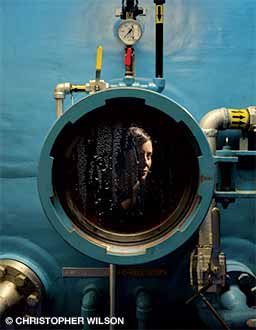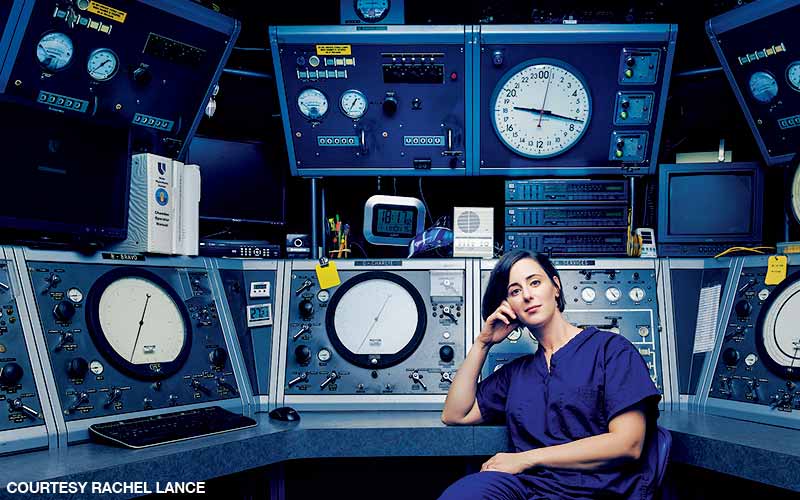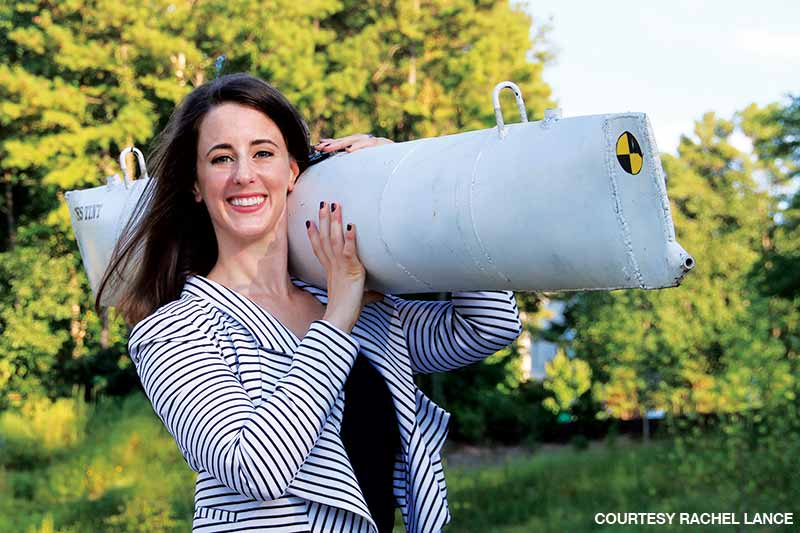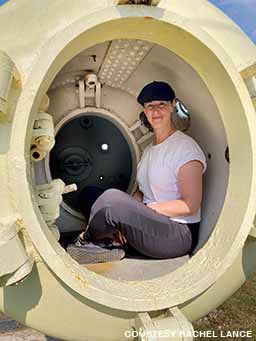Rachel Lance explores extreme environments and improving science communication.
Rachel Lance, Ph.D., is an assistant consulting professor at the Duke Center for Hyperbaric Medicine and Environmental Physiology and an author with Penguin Random House. She holds a bachelor’s and master’s degree in biomedical engineering from the University of Michigan and a Ph.D. in the same field from Duke University. Her initial work focused on the fluid mechanics of breathing and got her a job as a mechanical engineer with the U.S. Navy. When she came to Duke for her doctoral work, she began focusing on extreme environments, particularly the effects of explosions.

“Once I crawled inside the Duke hyperbaric chambers,” Lance said, “I fell in love and refused to leave.” She currently splits her time between work as a research professor and authoring nonfiction books about science.
What sparked your interest in diving and hyperbaric physiology?
The human body is fascinating, especially when it fails. We are not naturally equipped to survive in a deep underwater environment, so I am fascinated with the idea of finding ways to do so anyway. Perhaps it’s my naturally rebellious side.
What interested you first, diving or dive science?
Definitely diving. I began diving in Southern California in the dive park on Catalina Island, and I think I was the only person in my class who liked calculating dive tables. I loved the way we could apply math and physiology to keep us safe in what could otherwise be an incredibly hostile environment. After that I began volunteering at the University of Southern California Catalina Hyperbaric Chamber, where I would routinely pillage the onsite library for textbooks about dive science and read them while on a cliff overlooking the ocean. From there I was on a mission to make dive science a career.
How did you get into diving?
When I was in the second grade, my teacher gave us photocopies of John Goddard’s Life List. At a young age Goddard had listed all the things he wanted to accomplish during his life, which eventually encouraged him to become an adventurer. The assignment was for us to make our own list, but my eyes were laser-focused on one particular item on Goddard’s list: dive the Great Barrier Reef. I was a scrawny, myopic 6-year-old from inland Michigan, and the water petrified my mother, but literally all I could think to add to my life list were places to dive. From there it became a matter of time until I could scrape together the money and opportunity to learn.
What was your scariest dive?
My scariest dive happened when I was serving as a divemaster for an instructor friend. It was a beach dive off a jetty in Florida, and the water was murky, so even though the class was small and they weren’t going deep, he asked me to join and bring up the rear to keep the class together. I could barely see the fin tips of the student in front of me through the silt, but it quickly became apparent something terrible had happened to them.
I helped them surface quickly but safely, even though they were obviously in severe pain. It turned out some tourists had cast fishing lines over the class despite our prominent, visible dive buoy, and one of them had hooked the student, embedding the fishhook deep into their foot through their neoprene boot. I was thankful we hadn’t been deep when it happened, but I made sure to cut away the fisher’s bobber and weights as a small act of retaliation when I cut the student loose. The wound was bad enough that I had to tank-tow them back to shore for medical attention.
What is your favorite dive site?
I love the oil rigs off the Southern California coast. These rigs have stilt-like legs that reach hundreds of feet deep, giving the impression that you are diving in a bottomless deep blue cathedral topped with a stained-glass ceiling above you, full of frolicking sea lions. The currents can get quite ripping, but the beauty is unbelievable.

What did you work on for the U.S. Navy?
I worked at the Naval Surface Warfare Center Panama City Division, on the same base and right across the parking lot from the Navy Experimental Diving Unit. While I was working in Panama City, Florida, my main projects were rebreathers. I was in the branch that designed underwater equipment, but as a big dive nerd the rebreather projects were my favorite. I worked as the project engineer to convert the InnerSpace Megalodon rebreather into a military-grade model, which Navy personnel now use under the name UBA Mk28.
What do you do at Duke?
As assistant consulting professor at the Duke Center for Hyperbaric Medicine and Environmental Physiology, I research questions of survival in extreme environments, most often underwater. Since I am a biomedical engineer, I have a particular place in my heart for projects that develop and test new technology to better enable human survival underwater or allow measurement of what is happening with human physiology while we are underwater. Since hyperbarics and the deep ocean are unique environments, most common tools aren’t built for use in them, so our community has to engineer our own equipment to conduct medical research.
What are the remaining big topics in dive science that the community will face in the next 10 years?
I’m interested to see what we do with oxygen toxicity, specifically being able to predict central nervous system oxygen toxicity. Oxygen toxicity is such a monster of mystery that we don’t have great guidelines for predicting it, except to tell people to stay below a certain threshold. We don’t even have clear markers for predicting an oxygen convulsion if someone is hooked up to an electroencephalogram when the convulsion happens.
I think a couple of interesting projects are happening right now that have the potential to pull a few threads out of this complex knot and maybe begin to unravel it just a bit. New projects aim at looking at what’s happening inside the brain during elevated oxygen exposures. A few researchers are collectively working at putting together some new, larger data sets that might provide more insight.

What’s up with that Civil War submarine?
Oh, you mean my old pal, the H.L. Hunley? The Hunley was a homemade — yes, homemade — submarine used by the Confederacy during the Civil War. It became famous as the first submarine ever to sink an enemy ship in combat when it sank the USS Housatonic on Feb. 17, 1864, but it disappeared after its victory. Even after it was recovered in 2000, the mystery of its disappearance only deepened when the crew’s remains were discovered inside with no signs of skeletal damage.
The mystery of the Hunley started as a side interest and slowly snowballed until it consumed my life. It became part of my doctoral dissertation on underwater blast trauma, and I picked away at the story until I felt confident saying the underwater blast killed the crew. Because of my experience with dive science, I was able to evaluate the air supply inside the submarine’s hull and conclude that the crew likely didn’t die from running out of oxygen inside the enclosed space. That project was even more proof that a good base of dive knowledge will serve you well in unexpected places. I eventually turned that project’s story into a book when people kept asking me questions about the work, which is unusual when you’re a scientist.
How long did it take you to write the book?
It took about a year to write In the Waves, the book about the Hunley project. I had already compiled all the historical documents from working on the project during my doctoral dissertation, but I hadn’t researched the story’s human aspect. I wanted to make sure that I painted each character as a real, complete human being with nuance and complexity, and that took some legwork, given that they died more than 150 years ago.

You were recently out of the country to research another book. What’s the next one going to be about, and when can we expect to read it?
The next book is tentatively called The Chamber Divers: The Secret Work of a Maverick Group of Men and Women Who Helped Win World War II. As the name suggests, it’s about some hyperbaric chamber researchers. It is a nonfiction story of scientists who did some exciting and extremely dangerous experiments on themselves during the war. Almost everyone in the group had a serious injury during the testing, but what they learned about underwater survival ultimately enabled the scouting of the beaches of Normandy before D-Day, which informed the success of the landings. Their work was highly classified until 2001, which is why the story has never been public before. A highlight of the research was finding a handwritten note from Jacques Cousteau thanking the group for teaching him about underwater physiology.
Unfortunately, the timeline was delayed because of the pandemic limiting my ability to complete the research onsite in the U.K., but now that I have all the records I need, I am working at full speed. I am working with the same amazing literary team from In the Waves and am hopeful the book will come out in early 2023.
Is there anything else you would like to share with our readers?
When I was growing up, I always wanted to be a scientist or engineer and never thought of myself as a writer. Now that I am a scientist, engineer and writer, I realize how much overlap there is between those worlds. Everything about science is easier when you can clearly and succinctly convey the results of your work.
© Alert Diver — Q3/Q4 2021